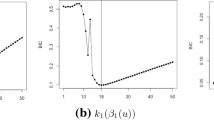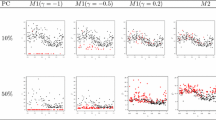Summary
The purpose of the present paper is to propose a practical Bayesian procedure for the estimation of binary response probability where the explanatory variable is bivariate. The procedure is an extension of the procedure for univariate case which was proposed by the present authors [2] and is based on a model which approximates the logistic transformation of response probability by a quadratic orthogonal spline function on the two-dimensional space of explanatory variable. The flexibility of the model is guaranteed by assuming a spline function on sufficiently fine mesh. To obtain stable estimates we introduce a prior distribution of the parameters of the model. The prior distribution has several parameters (hyper-parameters) which are chosen to minimize an Bayesian information criterion ABIC. The procedure is applicable cable to cases where each explanatory variable takes continuous values provided that the probability of the occurrence changes smoothly. The practical utility of the procedure is demonstrated by examples of applications to five sets of data.
Similar content being viewed by others
References
Akaike, H. (1980). Likelihood and Bayes procedure,Bayesian Statistics (eds. J. M. Bernardo, M. H. De Groot, D. U. Lindley and A. F. M. Smith), University Press, Valencia, Spain.
Ishiguro, M. and Sakamoto, Y. (1983). A Bayesian approach to binary response curve estimation,Ann. Inst. Statist. Math.,35, B, 115–137.
Ishiguro, M. and Sakamoto, Y. (1984). A Bayesian approach to the probability density estimation,Ann. Inst. Statist. Math.,36, B, 523–538.
Nakamura, T. (1982). A Bayesian cohort model for standard cohort table analysis,Proc. Inst. Statist. Math.,29, 77–97. (in Japanese).
Sakamoto, Y. and Akaike, H. (1978). Analysis of cross classified data by AIC,Ann. Inst. Statist. Math.,30, B, 185–197.
Sakamoto, Y. (1982). Efficient use of Akaike's information criterion for model selection in high dimensional contingency table analysis,Metron,40, 257–275.
Additional information
The Institute of Statistical Mathematics
About this article
Cite this article
Sakamoto, Y., Ishiguro, M. Bayesian binary regression involving two explanatory variables. Ann Inst Stat Math 37, 369–387 (1985). https://doi.org/10.1007/BF02481107
Received:
Revised:
Published:
Issue Date:
DOI: https://doi.org/10.1007/BF02481107




